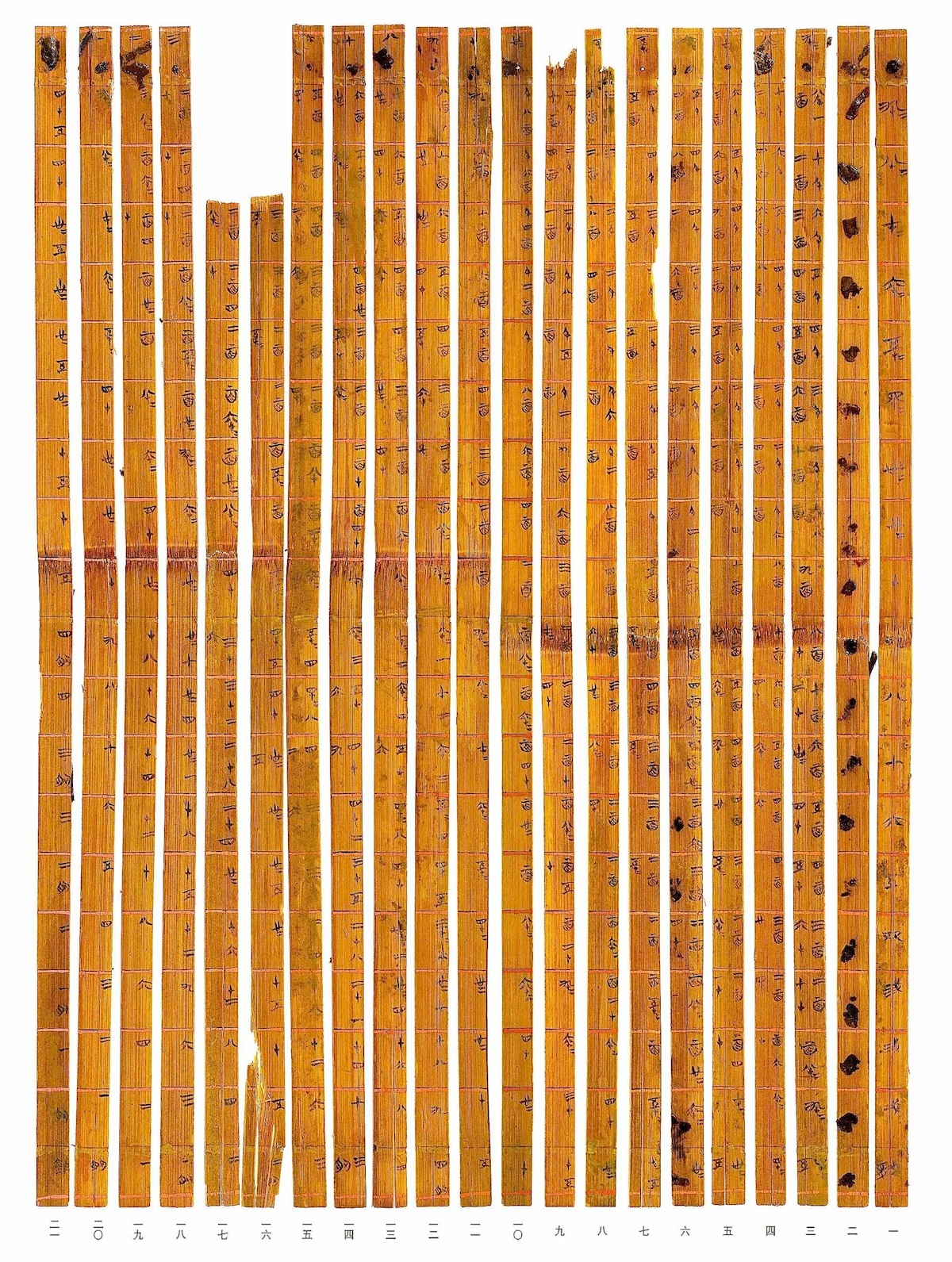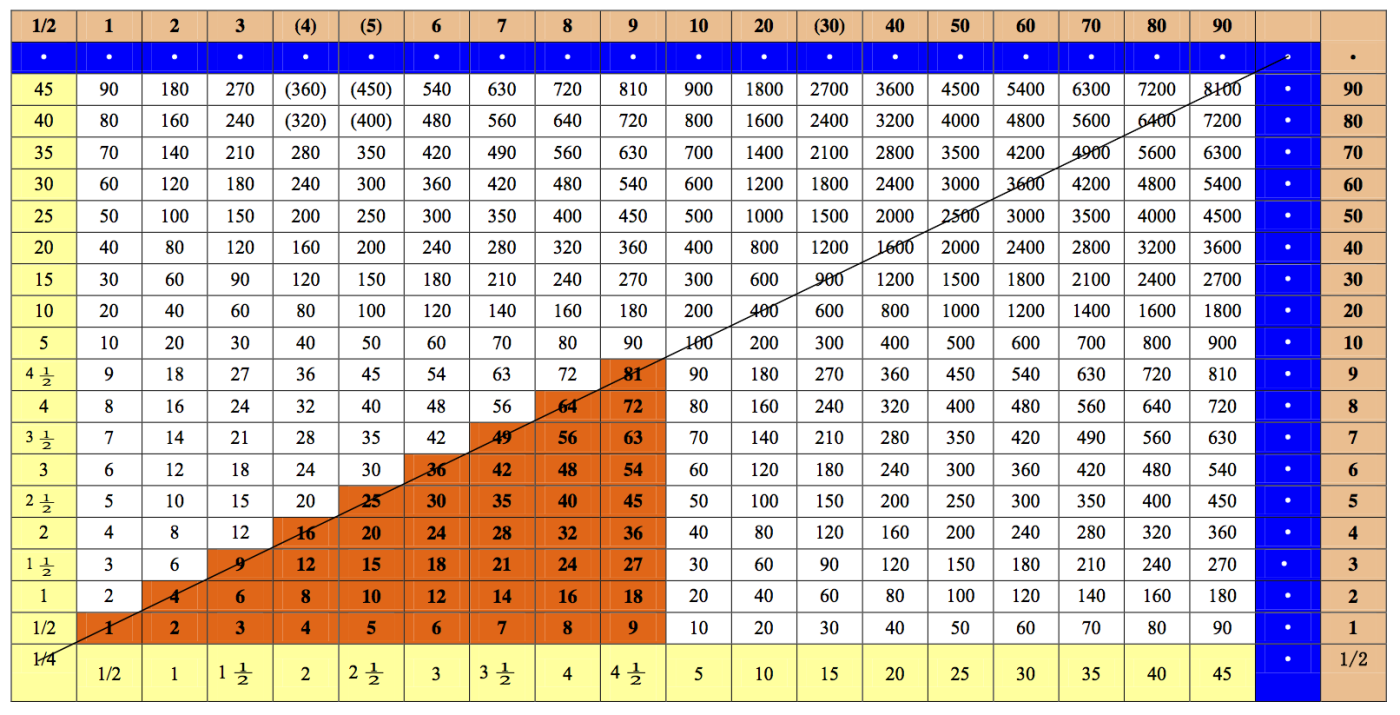Sunday, January 12, 2014 10:59:24 PM
Ancient times table hidden in Chinese bamboo strips

When assembled in the correct order, calligraphied bamboo strips from around 305 bc revealed a table for multiplying numbers up to 99.5.
Research and Conservation Centre for Excavated Text/Tsinghua Univ.
The 2,300-year-old matrix is the world's oldest decimal multiplication table.
Jane Qiu
07 January 2014
From a few fragments out of a collection of 23-century-old bamboo strips, historians have pieced together what they say is the world's oldest example of a multiplication table in base 10.
Five years ago, Tsinghua University in Beijing received a donation of nearly 2,500 bamboo strips. Muddy, smelly and teeming with mould, the strips probably originated from the illegal excavation of a tomb, and the donor had purchased them at a Hong Kong market. Researchers at Tsinghua carbon-dated the materials to around 305 bc, during the Warring States period before the unification of China.
Each strip was about 7 to 12 millimetres wide and up to half a metre long, and had a vertical line of ancient Chinese calligraphy painted on it in black ink. Historians realized that the bamboo pieces constituted 65 ancient texts and recognized them to be among the most important artefacts from the period.
“The strips were all mixed up because the strings that used to tie each manuscript together to form a scroll had long decayed,” says Li Junming, a historian and palaeographer at Tsinghua. Some pieces were broken, others missing, he adds: to decipher the texts was “like putting together a jigsaw puzzle”.
But “21 bamboo strips stand out from the rest as they contain only numbers, written in the style of ancient Chinese”, says Feng Lisheng, a historian of mathematics at Tsinghua.
Those 21 strips turned out to be a multiplication table, Feng and his colleagues announced in Beijing today during the presentation of the fourth volume of annotated transcriptions of the Tsinghua collection.
Times tables
When the strips are arranged properly, says Feng, a matrix structure emerges. The top row and the rightmost column contain, arranged from right to left and from top to bottom respectively, the same 19 numbers: 0.5; the integers from 1 to 9; and multiples of 10 from 10 to 90.

A translation of the oldest known decimal multiplication table.
Research and Conservation Centre for Excavated Text/Tsinghua Univ.
As in a modern multiplication table, the entries at the intersection of each row and column in the matrix provide the results of multiplying the corresponding numbers. The table can also help users to multiply any whole or half integer between 0.5 and 99.5. Numbers that are not directly represented, says Feng, first have to be converted into a series of additions. For instance, 22.5 × 35.5 can be broken up into (20 + 2 + 0.5) × (30 + 5 + 0.5). That gives 9 separate multiplications (20 × 30, 20 × 5, 20 × 0.5, 2 × 30, and so on), each of which can be read off the table. The final result can be obtained by adding up the answers. “It’s effectively an ancient calculator,” says Li.
The researchers suspect that officials used the multiplication table to calculate surface area of land, yields of crops and the amounts of taxes owed. “We can even use the matrix to do divisions and square roots,” says Feng. “But we can’t be sure that such complicated tasks were performed at the time.”
“Such an elaborate multiplication matrix is absolutely unique in Chinese history,” says Feng. The oldest previously known Chinese times tables, dating to the Qin Dynasty between 221 and 206 bc, were in the form of a series of short sentences such as “six eights beget forty-eight” and capable of only much simpler multiplications. The ancient Babylonians possessed multiplication tables some 4,000 years ago, but theirs were in a base-60, rather than base-10 (decimal), system. The earliest-known European multiplication table dates back to the Renaissance.
“The discovery is of extraordinary interest,” says Joseph Dauben, a maths historian at City University of New York. “It’s the earliest artefact of a decimal multiplication table in the world.”
It “certainly shows that a highly sophisticated arithmetic had been established for both theoretical and commercial purposes by the Warring States period in ancient China,” he adds. This was just before Qin Shi Huang, China's first emperor, united the country; he subsequently ordered book burnings and banned private libraries in an attempt to reshape the country's intellectual tradition.
Nature doi:10.1038/nature.2014.14482
*
Related stories
From nature.com
Polynesian people used binary numbers 600 years ago
16 December 2013
http://www.nature.com/news/polynesian-people-used-binary-numbers-600-years-ago-1.14380 (http://www.nature.com/doifinder/10.1038/nature.2013.14380 )
Dyscalculia: Number games
09 January 2013
http://www.nature.com/news/dyscalculia-number-games-1.12153 ( http://www.nature.com/doifinder/10.1038/493150a )
Charting the heavens from China
10 June 2009
http://www.nature.com/nature/journal/v459/n7248/full/459778a.html ( http://www.nature.com/doifinder/10.1038/459778a )
Why we should love logarithms
29 May 2008
http://www.nature.com/news/2008/080529/full/news.2008.866.html ( http://www.nature.com/doifinder/10.1038/news.2008.866 )
Were ancient Minoans centuries ahead of their time?
28 February 2006
http://www.nature.com/news/2006/060227/full/news060227-3.html ( http://www.nature.com/doifinder/10.1038/news060227-3 )
*
© 2014 Nature Publishing Group, a division of Macmillan Publishers Limited
http://www.nature.com/news/ancient-times-table-hidden-in-chinese-bamboo-strips-1.14482 [no comments yet]
---
(linked in):
http://investorshub.advfn.com/boards/read_msg.aspx?message_id=68250697 and preceding and following
from earlier this string, http://investorshub.advfn.com/boards/read_msg.aspx?message_id=80012325 and preceding and following
http://investorshub.advfn.com/boards/read_msg.aspx?message_id=80274636 and preceding and following
http://investorshub.advfn.com/boards/read_msg.aspx?message_id=87230821 and preceding and following
http://investorshub.advfn.com/boards/read_msg.aspx?message_id=95344740 and preceding (and any future following)
http://investorshub.advfn.com/boards/read_msg.aspx?message_id=95469526 and preceding and following
http://investorshub.advfn.com/boards/read_msg.aspx?message_id=95761871 and preceding and following
http://investorshub.advfn.com/boards/read_msg.aspx?message_id=95769214 and preceding (and any future following)
http://investorshub.advfn.com/boards/read_msg.aspx?message_id=95842172 and preceding (and any future following)
http://investorshub.advfn.com/boards/read_msg.aspx?message_id=95848515 and preceding (and any future following)

When assembled in the correct order, calligraphied bamboo strips from around 305 bc revealed a table for multiplying numbers up to 99.5.
Research and Conservation Centre for Excavated Text/Tsinghua Univ.
The 2,300-year-old matrix is the world's oldest decimal multiplication table.
Jane Qiu
07 January 2014
From a few fragments out of a collection of 23-century-old bamboo strips, historians have pieced together what they say is the world's oldest example of a multiplication table in base 10.
Five years ago, Tsinghua University in Beijing received a donation of nearly 2,500 bamboo strips. Muddy, smelly and teeming with mould, the strips probably originated from the illegal excavation of a tomb, and the donor had purchased them at a Hong Kong market. Researchers at Tsinghua carbon-dated the materials to around 305 bc, during the Warring States period before the unification of China.
Each strip was about 7 to 12 millimetres wide and up to half a metre long, and had a vertical line of ancient Chinese calligraphy painted on it in black ink. Historians realized that the bamboo pieces constituted 65 ancient texts and recognized them to be among the most important artefacts from the period.
“The strips were all mixed up because the strings that used to tie each manuscript together to form a scroll had long decayed,” says Li Junming, a historian and palaeographer at Tsinghua. Some pieces were broken, others missing, he adds: to decipher the texts was “like putting together a jigsaw puzzle”.
But “21 bamboo strips stand out from the rest as they contain only numbers, written in the style of ancient Chinese”, says Feng Lisheng, a historian of mathematics at Tsinghua.
Those 21 strips turned out to be a multiplication table, Feng and his colleagues announced in Beijing today during the presentation of the fourth volume of annotated transcriptions of the Tsinghua collection.
Times tables
When the strips are arranged properly, says Feng, a matrix structure emerges. The top row and the rightmost column contain, arranged from right to left and from top to bottom respectively, the same 19 numbers: 0.5; the integers from 1 to 9; and multiples of 10 from 10 to 90.

A translation of the oldest known decimal multiplication table.
Research and Conservation Centre for Excavated Text/Tsinghua Univ.
As in a modern multiplication table, the entries at the intersection of each row and column in the matrix provide the results of multiplying the corresponding numbers. The table can also help users to multiply any whole or half integer between 0.5 and 99.5. Numbers that are not directly represented, says Feng, first have to be converted into a series of additions. For instance, 22.5 × 35.5 can be broken up into (20 + 2 + 0.5) × (30 + 5 + 0.5). That gives 9 separate multiplications (20 × 30, 20 × 5, 20 × 0.5, 2 × 30, and so on), each of which can be read off the table. The final result can be obtained by adding up the answers. “It’s effectively an ancient calculator,” says Li.
The researchers suspect that officials used the multiplication table to calculate surface area of land, yields of crops and the amounts of taxes owed. “We can even use the matrix to do divisions and square roots,” says Feng. “But we can’t be sure that such complicated tasks were performed at the time.”
“Such an elaborate multiplication matrix is absolutely unique in Chinese history,” says Feng. The oldest previously known Chinese times tables, dating to the Qin Dynasty between 221 and 206 bc, were in the form of a series of short sentences such as “six eights beget forty-eight” and capable of only much simpler multiplications. The ancient Babylonians possessed multiplication tables some 4,000 years ago, but theirs were in a base-60, rather than base-10 (decimal), system. The earliest-known European multiplication table dates back to the Renaissance.
“The discovery is of extraordinary interest,” says Joseph Dauben, a maths historian at City University of New York. “It’s the earliest artefact of a decimal multiplication table in the world.”
It “certainly shows that a highly sophisticated arithmetic had been established for both theoretical and commercial purposes by the Warring States period in ancient China,” he adds. This was just before Qin Shi Huang, China's first emperor, united the country; he subsequently ordered book burnings and banned private libraries in an attempt to reshape the country's intellectual tradition.
Nature doi:10.1038/nature.2014.14482
*
Related stories
From nature.com
Polynesian people used binary numbers 600 years ago
16 December 2013
http://www.nature.com/news/polynesian-people-used-binary-numbers-600-years-ago-1.14380 (http://www.nature.com/doifinder/10.1038/nature.2013.14380 )
Dyscalculia: Number games
09 January 2013
http://www.nature.com/news/dyscalculia-number-games-1.12153 ( http://www.nature.com/doifinder/10.1038/493150a )
Charting the heavens from China
10 June 2009
http://www.nature.com/nature/journal/v459/n7248/full/459778a.html ( http://www.nature.com/doifinder/10.1038/459778a )
Why we should love logarithms
29 May 2008
http://www.nature.com/news/2008/080529/full/news.2008.866.html ( http://www.nature.com/doifinder/10.1038/news.2008.866 )
Were ancient Minoans centuries ahead of their time?
28 February 2006
http://www.nature.com/news/2006/060227/full/news060227-3.html ( http://www.nature.com/doifinder/10.1038/news060227-3 )
*
© 2014 Nature Publishing Group, a division of Macmillan Publishers Limited
http://www.nature.com/news/ancient-times-table-hidden-in-chinese-bamboo-strips-1.14482 [no comments yet]
---
(linked in):
http://investorshub.advfn.com/boards/read_msg.aspx?message_id=68250697 and preceding and following
from earlier this string, http://investorshub.advfn.com/boards/read_msg.aspx?message_id=80012325 and preceding and following
http://investorshub.advfn.com/boards/read_msg.aspx?message_id=80274636 and preceding and following
http://investorshub.advfn.com/boards/read_msg.aspx?message_id=87230821 and preceding and following
http://investorshub.advfn.com/boards/read_msg.aspx?message_id=95344740 and preceding (and any future following)
http://investorshub.advfn.com/boards/read_msg.aspx?message_id=95469526 and preceding and following
http://investorshub.advfn.com/boards/read_msg.aspx?message_id=95761871 and preceding and following
http://investorshub.advfn.com/boards/read_msg.aspx?message_id=95769214 and preceding (and any future following)
http://investorshub.advfn.com/boards/read_msg.aspx?message_id=95842172 and preceding (and any future following)
http://investorshub.advfn.com/boards/read_msg.aspx?message_id=95848515 and preceding (and any future following)
Join the InvestorsHub Community
Register for free to join our community of investors and share your ideas. You will also get access to streaming quotes, interactive charts, trades, portfolio, live options flow and more tools.










